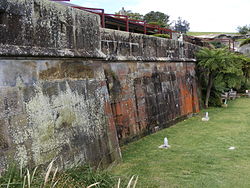| Georges Head Battery | |
|---|---|
| Part of Chowder Bay Barracks Group | |
| Chowder Bay Road, Georges Heights, New South Wales Near Sydney in Australia | |
 Exterior of gunners' barracks attached to the Georges Head Battery | |
Location in Greater Metropolitan Sydney | |
| Coordinates | 33°50′11″S 151°15′29″E / 33.83639°S 151.25806°E |
| Site information | |
| Owner | Office of Environment & Heritage |
| Operator | |
| Site history | |
| Built | 1801–1873 |
| In use | 1801–2002 |
| Fate | Decommissioned; remnants now contained within the Sydney Harbour National Park |
| Architect | James Barnet |
| Official name | Chowder Bay Barracks Group, Chowder Bay Rd, Georges Heights, NSW, Australia |
| Type | Listed place |
| Designated | 22 June 2004 |
| Reference no. | 105254 |
| Class | Historic |
| Place File No | 1/13/026/0008 |
| Official name | Georges Head Military Fortifications |
| Type | State heritage (complex / group) |
| Designated | 2 April 1999 |
| Reference no. | 987 |
| Type | Fortification |
| Category | Defence |
The Georges Head Battery, also called the Georges Head Military Fortifications, is a heritage-listed former military fortification located on the Georges Head on Chowder Bay Road, Georges Heights, New South Wales, Australia.[1]
The site consists of the original battery and barracks, designed by Colonial Architect James Barnet, located at the end of Suakin Drive, Georges Heights, two later batteries located adjacent to the corner of Middle Head Road and Best Avenue, Georges Heights, and the Beehive (or Lower) Casemate adjacent to the Armoured (or Upper) Casemate in Chowder Bay Road. The Georges Head Battery is one of three forts in the area that were built for the purpose of defending the outer harbour. The other two forts are located at Middle Head and Bradleys Head, Mosman. The fort became a command post in the 1890s for the coordination of all of Sydney's harbour defences. It was decommissioned in 2002 and part of the land is managed by the Sydney Harbour Federation Trust, with other parts managed by the NSW National Parks & Wildlife Service as part of the Sydney Harbour National Park.[2] The property is owned by Office of Environment & Heritage.
The site was added to the New South Wales State Heritage Register on 2 April 1999.[1]
- ^ a b "Georges Head Military Fortifications". New South Wales State Heritage Register. Department of Planning & Environment. H00987. Retrieved 2 June 2018.
 Text is licensed by State of New South Wales (Department of Planning and Environment) under CC BY 4.0 licence.
Text is licensed by State of New South Wales (Department of Planning and Environment) under CC BY 4.0 licence.
- ^ "Headland Park and its military heritage" (PDF) (PDF brochure). Sydney Harbour Federation Trust. Retrieved 5 October 2014.
